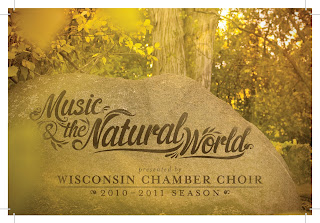The Wisconsin Chamber Choir presents:
War and Peace
Friday, November 18, 7:30 pm
Trinity Lutheran Church, 1904 Winnebago St.
Tickets: $14 advance/$16 door (Students $10)
This fall, as Americans reflect on the tenth anniversary of the 9/11 attacks and the ongoing wars in Iraq and Afghanistan, the Wisconsin Chamber Choir presents a timely concert on the theme “War and Peace.” Featured works include Charles Ives’s monumental Psalm 90, Lee Hoiby’s Last Letter Home, Maurice Ravel’s Trois beaux oiseaux du paradis, Rudolf Mauersberger’s Wie liegt die Stadt so wüst, Tokuhide Niimi’s Rainbow over Hiroshima, and J. S. Bach’s Dona nobis pacem, the glorious final movement of Bach’s B-minor Mass.
In addition to the musical offerings by the WCC, this event will include an exhibition of “Spirit Boxes” by Madison photographer/artist Andre Ferrella. As part of Ferrella’s ongoing project, The Rise of the Fallen, his Spirit Boxes commemorate those who have fallen in Iraq and Afghanistan. Ferrella’s work has been praised by critics worldwide for its evocative and timeless qualities. For further information about Ferrella’s project, visit www.theriseofthefallen.org.
Throughout history, artists and composers have confronted the issues of war and peace, conflict and resolution, violence and community. The WCC’s November 18 concert will be structured around five conflicts that have found particular resonance in music: the Thirty Years War in seventeenth-century Europe, The U.S. Civil War, World Wars I and II, and the American war in Iraq.
The program opens with a pair seventeenth-century works: Verleih uns Frieden (“Grant Us Peace”) by Heinrich Schütz, composed amid the devastation of the Thirty Years War in Germany; and Jean Baptiste Lully’s Jubilate Deo, subtitled “La motet pour la paix” (“The Motet for the Peace”), a grand work written in celebration of the Peace of the Pyrenees that marked the end of hostilities between France and Spain in 1680.
Beat, Beat, Drums, by American composer Howard Hanson, sets a passage from Walt Whitman’s famous Civil War poem, Drum Taps. In a contrasting mood, Oh For Such a Dream by Wisconsin native Daron Hagen, brings to life the words of Ann Smith, whose poignant letter to her husband David expresses her longing for him to return from the battlefield, and her foreboding that “now there are to be thousands more dragged from their homes.”
In 1917, shortly after the United States entered World War I, American composer Charles Ives penned the choral song He is There! in support of the war effort. With its quotations of no fewer than eleven patriotic tunes, this rousing march-like piece shows the folksy side of Ives’s temperament. In a more serious vein, Psalm 90 is Ives’s masterpiece in the choral genre, and his own favorite work. Although not directly related to a specific world event, Psalm 90 portrays a powerful progression from dense cluster chords that depict notions of wrath and destruction, to a serene ending that exudes peace and contentment.
Choral fans are familiar with Herbert Howells’s moving anthem, Like as the Hart, but many may not be aware that this piece, along with three other anthems composed at the same time, represent Howells’s response to the Nazi blitzkrieg against London, during which Howells was bombed out of his house and had to retreat to the countryside. The WCC presents a rare performance of the last anthem of this set, Let God Arise. Near the end of World War II, the German choral conductor Rudolf Mauersberger composed a different sort of response to the war. After the unprecedented firebombing of Dresden on February 13, 1945, in which a number of Mauersberger’s own choir boys perished—along with tens of thousands of additional civilians—Mauersberger was compelled to compose Wie liegt die Stadt so wüst, (“How Desolate Sits the City”) using verses from the Lamentations of Jeremiah to bemoan the utter destruction of “Florence on the Elbe,” as Dresden had been known until that day. Halfway around the world the Japanese people experienced an even more gruesome fate in the atomic bombing of Hiroshima and Nagasaki. Contemporary Japanese composer Tokuhide Niimi composed his extended choral work, Inori-no Niji (“Rainbow from God”) as a memorial both to the destruction of Hiroshima and to the city’s rebirth in the decades since the war. The WCC presents the final movement from this compelling work, sung in the original Japanese.
Last Letter Home, composed by Madison native Lee Hoiby, brings the topic of war up to date. Written in 2006, the work is a setting of a letter by Jesse Givens, Private First Class, to his wife Melissa, son Dakota, and unborn child Carson. Givens was killed in Iraq in 2003 and his letter reached Melissa in the maternity ward. Hoiby’s music captures the warmth and the tragedy of Givens’s incredibly moving words.
J. S. Bach’s uplifting Dona nobis pacem, the final movement of Bach’s Mass in B-minor, follows the Hoiby as a final prayer for peace.
Founded in 1999, the Madison-based Wisconsin Chamber Choir has established a reputation for excellence in the performance of repertoire ranging from Bach oratorios, a cappella masterworks, and world-premieres. Writing in the Isthmus, critic John Barker praised the choir’s 2010 rendition of Bach’s St. John Passion as “a remarkably consistent, coherent, and artistically splendid achievement.” Dr. Robert Gehrenbeck is the Wisconsin Chamber Choir’s artistic director.






